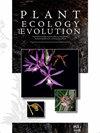The fate of Holoregmia, a monospecific genus endemic to the Brazilian Caatinga, under different future climate scenarios
IF 1.1
4区 生物学
Q3 PLANT SCIENCES
引用次数: 1
Abstract
Background and aims – Climatic fluctuations during the Pleistocene altered the distribution of many species and even entire biomes, allowing some species to increase their range while others underwent reductions. Recent and ongoing anthropogenic climate change is altering climatic patterns very rapidly and is likely to impact species’ distributions over shorter timescales than previous natural fluctuations. Therefore, we aimed to understand how Pleistocene and Holocene climatic fluctuations might have shaped the current distribution of Holoregmia and explore its expected distribution under future climate scenarios. Material and methods – We modelled the potential distribution of Holoregmia viscida (Martyniaceae), a monospecific plant genus endemic to the semi-arid Caatinga Domain in Brazil. We used an ensemble approach to model suitable areas for Holoregmia under present conditions, Paleoclimatic scenarios, and global warming scenarios in 2050 and 2090. Key results – Holocene climates in most Caatinga were too humid for Holoregmia, which restricted its suitable areas to the southern Caatinga, similar to its current distribution. However, under global warming scenarios, the Caatinga is expected to become too dry for this lineage, resulting in a steady decline in the area suitable for Holoregmia and even its possible extinction under the most pessimistic scenario modelled. Conclusion – The predicted extinction of the ancient and highly specialized Holoregmia viscida highlights the possible consequences of climate change for some species of endemic Caatinga flora. Invaluable phylogenetic diversity may be lost in the coming decades, representing millions of years of unique evolutionary history and consequent loss of evolutionary potential to adapt to future environmental changes in semi-arid environments.Holoregmia是巴西Caatinga特有的单种属,在未来不同气候情景下的命运
背景和目的-更新世期间的气候波动改变了许多物种甚至整个生物群落的分布,使一些物种的范围增加,而另一些物种的范围则减少。最近和目前的人为气候变化正在非常迅速地改变气候模式,并可能在比以往自然波动更短的时间尺度上影响物种的分布。因此,我们的目的是了解更新世和全新世气候波动如何影响全息藻的当前分布,并探索其在未来气候情景下的预期分布。材料和方法-我们模拟了Holoregmia visida (Martyniaceae)的潜在分布,这是巴西半干旱Caatinga地区特有的单种植物属。我们使用集合方法模拟了2050年和2090年在当前条件下、古气候情景下和全球变暖情景下适合全息重现的区域。主要结果——全新世的气候对于Holoregmia来说过于潮湿,这限制了它的适宜区域在Caatinga南部,类似于它现在的分布。然而,在全球变暖的情况下,卡廷加预计会变得过于干燥,不适合这个谱系,导致适合全息鲨的区域不断减少,甚至在最悲观的情况下,它可能会灭绝。结论:预测的古代高度特化的Holoregmia visida的灭绝,突出了气候变化对一些Caatinga特有植物群的可能后果。在未来的几十年里,宝贵的系统发育多样性可能会丧失,这代表着数百万年独特的进化史,并因此丧失了适应未来半干旱环境中环境变化的进化潜力。
本文章由计算机程序翻译,如有差异,请以英文原文为准。
求助全文
约1分钟内获得全文
求助全文
来源期刊

Plant Ecology and Evolution
PLANT SCIENCES-
CiteScore
2.20
自引率
9.10%
发文量
27
审稿时长
>12 weeks
期刊介绍:
Plant Ecology and Evolution is an international peer-reviewed journal devoted to ecology, phylogenetics and systematics of all ‘plant’ groups in the traditional sense (including algae, cyanobacteria, fungi, myxomycetes), also covering related fields.
The journal is published by Meise Botanic Garden and the Royal Botanical Society of Belgium.
 求助内容:
求助内容: 应助结果提醒方式:
应助结果提醒方式:


